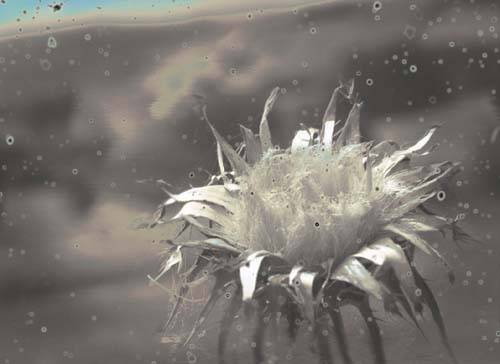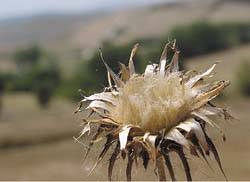Daguerreotype Effects
|
|
|
The daguerreotype was invented by Louis Jacques Mande Daguerre and patented in 1839 as the first successful method for capturing and fixing a photographic image. The original process involved chemically sensitizing a copper plate with bitumen of Judea, exposing it through a camera obscura, and developing the image using vapor of mercury. As the process was perfected, the copper plate was coated with a thin layer of silver, making the surface highly reflective and giving it the appearance of a mirror. These images were sometimes col ored using pigments, and the copper sometimes tarnished with age, creating other areas of discoloration. Because the image was so reflective, it can appear as both a negative and positive image, depending on the angle from which it's viewed. The handmade nature of the plates often created spots and blemishes resulting from dust, brushstrokes created when coating the plates, and unevenness in applying the emulsions. When I simulate daguerreotypes, I like to embrace these imperfections and include them as graphic texture and detail. Remember that each image was unique and reflected a true spirit of experimentation. Focus and detail was sometimes elusive, and depth of field was often very shallow. Vary the use of dust spots and discoloration as you wish and remember that the final design is more important than being faithful to the replication of the process. Pod in Landscape
About the Original Image I was driving south of Siena on a rolling country road when I stopped to shoot the landscape (as I did a few dozen times a day). In this instance, I looked down to see a seed pod growing next to the road. Initially, I was drawn to its detail and texture, but after taking a few shots I decided to shoot it from a low angle so that I could capture the landscape in the background. I still wanted the detail in the plant, knowing that this would shift the background landscape way out of focus. My idea was to imply the landscape through shape and color without losing the emphasis on the main subject. Building the EffectThe first step is to add shadows and depth to the image. You tend to see light fall off at the edges and around the corners of the image. The brightest areas are often the center of the frame. I duplicated the Background layer and applied a curve to darken the entire layer. I selected Image, Adjustments, Curves and created a single data point with a value of Input: 150, Output: 96, and clicked OK to apply the effect. I then clicked the Add Layer Mask icon and painted the center of the duplicate layer with a 300-pixel feathered brush with black as the foreground color. This mask brightened the center of the image, leaving the corners and edges dark (see Figure
Removing the ColorThe next step was to replace the color in the image with a toned sepia color, simulating the look of an aged photograph. I selected Gradient Map from the Adjustment Layer pull-down menu in the Layers palette and clicked the gradient strip in the dialog box that appeared, launching the Gradient Editor. I double-clicked the color stop on the left end of the gradient and elected pure white in the Color Picker I set the color stop on the right side to black, following the same procedure. I then clicked below the gradient to add two additional color stops. I set the first stop to location 35% with an RGB value of R203, G193, B146. I set the second stop to location 68% with an RGB value of R105, G90, B75. I clicked OK to close all the dialog boxes to apply the gradient to the image (see Figure
Adding Metallic Patina and Lowering ContrastI added two more gradient map adjustment layers to complete the toning process. The first introduced a red-and-teal color gradient that simulated the metallic patina that is often found in daguerreotype images. The second toned everything to more of a neutral black and white while lightening the blacks to create a faded look. For the first gradient, I followed the same procedure as before to launch the Gradient Editor and created a gradient with six color stops, with values as follows: Stop 1: Location 0, RGB value R255, G255, B255. Stop 2: Location 24%, RGB value R50, G81, B243. Stop 3: Location 40%, RGB value R108, G135, B168. Stop 4: Location 61%, RGB value R201, G193, B153. Stop 5: Location 80%, RGB value R105, G90, B75. Stop 6: Location 100%, RGB value R0, G0, B0. Again, these settings will vary from image to image; the key is to create the color transitions and position the color stops so that they appear in the desired areas of the image. After creating this first gradient, I set its blending mode to Pin Light and added a layer mask, painting out the plant section and a bit of the upper-left corner. The gradient added the blue accents to some of the highlight areas without dominating the entire image. Finally I added a gray-to-white gradient map, creating a simple two-stop gradient. I set the first stop to location 0% with an RGB value of R255, G255, B255. I set the second stop to location 100% with an RGB value of R98, G96, B96. Finally, I set the layer opacity for this second gradient to 42% to lighten the effect (see Figure
Blurring the DetailsNow the image looked too sharp and crisp to be a convincing daguerreotype; it reflected the high-quality Nikon optics that were unavailable circa 1839. I duplicated the Background layer and positioned it above the Curves adjustment layer and beneath the gradient map layers. I selected the Blur tool from the toolbox, specified a 200-pixel brush, and set the Strength at 50% in the Options bar. I painted the center of the seed pod that had the most detail, applying the blur directly to that area. I duplicated the Background layer a second time, positioned it above the previous blur layer, and chose Filter, Blur, Motion Blur. I set the Angle to 0° and the Distance slider to 19 pixels and clicked OK to blur the background slightly. Finally, I clicked the Add New Layer icon to create a third blur layer above the motion blur, and selected the Brush tool with a 200-pixel brush set to 14% Opacity. I Option-clicked (Alt-clicked in Windows) the highlight areas of the image to sample the global highlight color and painted in the area in the lower-left area of the seed pod to blur and lighten it slightly (see Figure
Add the Dust SpecksThe final step was to add the dust specks indicative of many daguerreotypes. I added a fairly dense dot pattern because I liked what it did to this image, but you can vary the density based on your image and preference. I used a scan of paint splatters on white paper for the original pattern, similar to the ones used in Chapter 12, "Molecola Sogni," and Chapter 14, "Parte Interna." I opened the scan and used the Magic Wand tool to select one of the droplets; then I chose Select, Similar to select all the droplets. I copied the selections and pasted them into the composite image; then I selected Edit, Free Transform and repositioned the droplets by dragging the corner handles to set the right proportion. Then I duplicated the droplet layer by dragging it to the Create New Layer icon in the Layers palette. I selected Image, Transform, Flip Horizontal to flip the duplicate droplet layer, and then selected Image, Transform, Flip Vertical to flip it upside down, concealing some of the symmetry. I used the Move tool to drag the copied layer to the right. I held down the Shift key and clicked both droplet layers in the Layers palette to select both layers and then chose New Group from Layers from the Layers palette menu. Iadded a mask to the layer group and masked out any mirrored specks to conceal any last traces of the symmetry (see Figure
I selected both layers in the new group and selected Merge Layers from the Layers palette menu. I selected Outer Glow from the Add Layer Style icon at the bottom of the Layers palette and double-clicked the Glow Color swatch, selecting an RGB color of R233, G227, B187, and leaving all other settings at their defaults. I then dragged the merged layer to the Add New Layer icon to duplicate it. With the topmost droplet layer selected, I chose Filter, Blur, Gaussian Blur and set the Radius Slider to 1.6 pixels to create a blurred halo around each of the specks. To make some of the specks white instead of black, I added a Curves adjustment layer to the layer group above the blurred dots layer, and inverted the tonality, setting the 0 point at 255 and the 255 point to 0. I highlighted the Curves layer mask, selected the Paintbucket tool with black as the foreground color, and clicked in the image area to create a mask filled with black, obscuring the adjustment layer. Then, with a small feathered brush set to white, I painted back any spots I wanted to appear as lighter specks. Finally, I created a new layer and painted in the tiny white flecks that sometimes appear in the center of the dust specks (see Figure
|
|
|
EAN: 2147483647
Pages: 141







